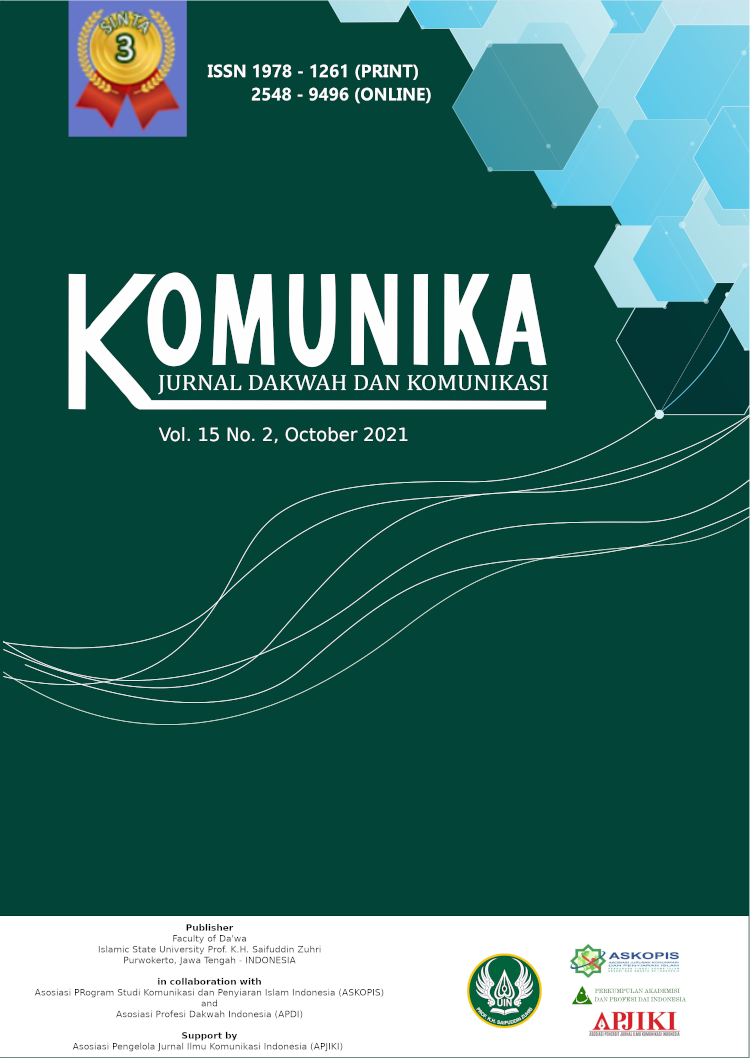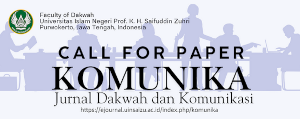Rhetoric in Islamic Tradition: Paradigm and Its Development
DOI:
https://doi.org/10.24090/komunika.v15i2.4570Keywords:
Rhetoric, Balaghah, Khithobah, Preaching of IslamAbstract
Rhetoric has an essential role in developing Islamic civilization and da’wah. Rhetoric in the Islamic tradition has a dualistic paradigm that appears with two faces, specifically balaghah and khithobah. The character of balaghah is inherent in the rhetorical tradition, where the qualification of the message language is essential, including eloquence, meaning, and metaphor. In comparison, the khithobah character is attached to the quality aspects of the message content and the technique of delivering the message. This literature research found that the two faces of this rhetoric have further developments, one is progressive, and the other is still stagnant. The progress of balaghah is not only based on the role of Arabic as the Quran language but also the miracle of the Quran language itself. While khithobah is an essential part of delivering Islamic symbols, it is still considered a mere praxis and religious routine, and it has not developed as scientifically theoretic. Amid the limitations of the study of khitobah as part of Islamic rhetoric, this paper will elaborate on the dynamics and span developments periods.Downloads
Download data is not yet available.
References
Al-Hasyimi, A. (1999). Jawahir al Balaghah (Cet ke 1). Maktabah al Ashriyah.
Al-Qardhawi, D. Y. (2007). Retorika Islam: Bagaimana Seharusnya Menampilkan Wajah Islam (Edisi Indonesia) (kedua). Pustaka Al-Kautsar
Albitar, M. (2009). The Jewels of Rhetoric Jawahir Al-Balaghah Arabic Rhetoric Thesis Translation Project Case Study. Hawaii Pacific University.
Ali Asyri Zaid. (2006). Al-Balaghah Al-Arabiyah: Tarihuha Masadiruha Manahijuha. Maktabah al-Adab.
Errihani, M. (2011). Managing religious discourse in the mosque: The end of extremist rhetoric during the Friday sermon. Journal of North African Studies, 16(3). https://doi.org/10.1080/13629387.2010.515411
Hamka. (2018). Prinsip dan Kebijaksanaan Dakwah. Gema Insani Press
Haque, M. (2010). Impact of the Controversy between al-Ghazali and Ibn Rushd on the Development of Islamic Thought. Transcendent Philosophy Journal, 11.
Hart, R. P., & Lind, C. J. (2011). The rhetoric of Islamic activism: A DICTION study. Dynamics of Asymmetric Conflict, 4(2), 113–125.
Hasanah, U. (2017). Majelis taklim perempuan dan perubahan sosial pada masyarakat perkotaan. PKBM Ngudi Ilmu.
Hasanah, U. (2020a). Kualifikasi Da'i: Komparasi Konseptual Retorika Dakwah dan Retorika Aristoteles. Jurnal Komunikasi Islam, 10(2), 256–275.
Hasanah, U. (2020b). Retorika Dakwah Kontemporer. Media Madani.
Høigilt, J. (2013). Islamist rhetoric: Language and culture in contemporary Egypt. In Islamist Rhetoric: Language and Culture in Contemporary Egypt. Taylor and Francis. https://doi.org/10.4324/9780203841778
Khatibah, K. K., Yuslem, N., & Abdullah, A. (2018). PROPHET MUHAMMADS RHETORIC; An Analysis of Prophet Muhammad Speech on Wada Pilgrim in Sahih al-Bukhari. INTERNATIONAL JOURNAL ON LANGUAGE, RESEARCH AND EDUCATION STUDIES, 2(2), 281– 293
Lea Clark, C. (2007). Aristotle and Averroes: The Influences of Aristotle’s Arabic Commentator upon Western European and Arabic Rhetoric. Review of Communication, 7(4). https://doi. org/10.1080/15358590701596955
Madjid, N. (1992). Islam Doktrin dan Peradaban. Paramadina.
Mandzur ibnu. (2013). Lisan al-Arab (ke-3). Dar al-Hadits
Millie, J. (2013). The situated listener as problem: ‘Modern’ and ‘traditional’ subjects in Muslim Indonesia. International Journal of Cultural Studies, 16(3), 271–288
Nasional, D. P. (2003). Ensiklopedi Islam. PT Ichtiar Baru Van Houve.
Nasr, S. H. (2005). The need for a sacred science. Routledge
Natsir, M. (1996). Fiqhud Da’wah (ke-10). Capita Selecta.
Rajiyem. (2005). Sejarah Dan Perkembangan Retorika. Humaniora, 17(2), 142–153.
Rakhmat, J. (2011). Retorika Moderen Pendekatan Praktis. Rosda Karya.
Safitri, D. (2017). Kontestasi Retorika Islam Nusantara. Ilmu Dakwah: Academic Journal for Homiletic Studies, 11(2), 235–256.
Samuri, M. A. A., & Hopkins, P. (2017). Voices of Islamic Authorities: Friday Khutba in Malaysian Mosques. Islam and Christian Muslim Relations, 28(1), 47–67. https:// doi.org/10.1080/09596410.2017.1280 916
Sayid Syarif Radhi. (2006). Nahjul Balaghah, edisi Indonesia. Lentera.
Scholz, J. (2018). Dramatic Islamic Preaching: A Close Reading of 'Amr Khalid. Religion and Aesthetic Experience, 149
Scholz, J. (2019). Modern Arabic rhetorical manuals: A transcultural phenomenon. In Engaging Transculturality (pp. 170–184). Routledge.
Shihab, Quraish. (2011). Kemukjizatan Al-Qur'an: Ditinjau dari aspek kebahasaan, Isyarat ilmiah dan Pemberitaan Ghaib. Mizan.
Suryadilaga, M. A. (2011). Hadis-Hadis tentang Perempuan sebagai Imam Shalat. Musawa Jurnal Studi Gender Dan Islam, 10(1), 1–32
Trilaksono, B. H., Prasetyawan, W., Amirudin, A., & Rizky, K. (2021). MEDIA RETORIKA DAKWAH PADA ERA MILENIAL. Q1 Jurnal Komunikasi Dan Penyiaran Islam, 1(1)
Zain, A., & Maturidi, M. (2021). Interreligious Relations in the Structural Da’wah Framework. KOMUNIKA: Jurnal Dakwah Dan Komunikasi, 15(1), 97–109.
Zed, M. (2017). Metode Penelitian Kepustakaan (cet ke-4). Yayasan Pustaka Obor Indonesia.
Al-Qardhawi, D. Y. (2007). Retorika Islam: Bagaimana Seharusnya Menampilkan Wajah Islam (Edisi Indonesia) (kedua). Pustaka Al-Kautsar
Albitar, M. (2009). The Jewels of Rhetoric Jawahir Al-Balaghah Arabic Rhetoric Thesis Translation Project Case Study. Hawaii Pacific University.
Ali Asyri Zaid. (2006). Al-Balaghah Al-Arabiyah: Tarihuha Masadiruha Manahijuha. Maktabah al-Adab.
Errihani, M. (2011). Managing religious discourse in the mosque: The end of extremist rhetoric during the Friday sermon. Journal of North African Studies, 16(3). https://doi.org/10.1080/13629387.2010.515411
Hamka. (2018). Prinsip dan Kebijaksanaan Dakwah. Gema Insani Press
Haque, M. (2010). Impact of the Controversy between al-Ghazali and Ibn Rushd on the Development of Islamic Thought. Transcendent Philosophy Journal, 11.
Hart, R. P., & Lind, C. J. (2011). The rhetoric of Islamic activism: A DICTION study. Dynamics of Asymmetric Conflict, 4(2), 113–125.
Hasanah, U. (2017). Majelis taklim perempuan dan perubahan sosial pada masyarakat perkotaan. PKBM Ngudi Ilmu.
Hasanah, U. (2020a). Kualifikasi Da'i: Komparasi Konseptual Retorika Dakwah dan Retorika Aristoteles. Jurnal Komunikasi Islam, 10(2), 256–275.
Hasanah, U. (2020b). Retorika Dakwah Kontemporer. Media Madani.
Høigilt, J. (2013). Islamist rhetoric: Language and culture in contemporary Egypt. In Islamist Rhetoric: Language and Culture in Contemporary Egypt. Taylor and Francis. https://doi.org/10.4324/9780203841778
Khatibah, K. K., Yuslem, N., & Abdullah, A. (2018). PROPHET MUHAMMADS RHETORIC; An Analysis of Prophet Muhammad Speech on Wada Pilgrim in Sahih al-Bukhari. INTERNATIONAL JOURNAL ON LANGUAGE, RESEARCH AND EDUCATION STUDIES, 2(2), 281– 293
Lea Clark, C. (2007). Aristotle and Averroes: The Influences of Aristotle’s Arabic Commentator upon Western European and Arabic Rhetoric. Review of Communication, 7(4). https://doi. org/10.1080/15358590701596955
Madjid, N. (1992). Islam Doktrin dan Peradaban. Paramadina.
Mandzur ibnu. (2013). Lisan al-Arab (ke-3). Dar al-Hadits
Millie, J. (2013). The situated listener as problem: ‘Modern’ and ‘traditional’ subjects in Muslim Indonesia. International Journal of Cultural Studies, 16(3), 271–288
Nasional, D. P. (2003). Ensiklopedi Islam. PT Ichtiar Baru Van Houve.
Nasr, S. H. (2005). The need for a sacred science. Routledge
Natsir, M. (1996). Fiqhud Da’wah (ke-10). Capita Selecta.
Rajiyem. (2005). Sejarah Dan Perkembangan Retorika. Humaniora, 17(2), 142–153.
Rakhmat, J. (2011). Retorika Moderen Pendekatan Praktis. Rosda Karya.
Safitri, D. (2017). Kontestasi Retorika Islam Nusantara. Ilmu Dakwah: Academic Journal for Homiletic Studies, 11(2), 235–256.
Samuri, M. A. A., & Hopkins, P. (2017). Voices of Islamic Authorities: Friday Khutba in Malaysian Mosques. Islam and Christian Muslim Relations, 28(1), 47–67. https:// doi.org/10.1080/09596410.2017.1280 916
Sayid Syarif Radhi. (2006). Nahjul Balaghah, edisi Indonesia. Lentera.
Scholz, J. (2018). Dramatic Islamic Preaching: A Close Reading of 'Amr Khalid. Religion and Aesthetic Experience, 149
Scholz, J. (2019). Modern Arabic rhetorical manuals: A transcultural phenomenon. In Engaging Transculturality (pp. 170–184). Routledge.
Shihab, Quraish. (2011). Kemukjizatan Al-Qur'an: Ditinjau dari aspek kebahasaan, Isyarat ilmiah dan Pemberitaan Ghaib. Mizan.
Suryadilaga, M. A. (2011). Hadis-Hadis tentang Perempuan sebagai Imam Shalat. Musawa Jurnal Studi Gender Dan Islam, 10(1), 1–32
Trilaksono, B. H., Prasetyawan, W., Amirudin, A., & Rizky, K. (2021). MEDIA RETORIKA DAKWAH PADA ERA MILENIAL. Q1 Jurnal Komunikasi Dan Penyiaran Islam, 1(1)
Zain, A., & Maturidi, M. (2021). Interreligious Relations in the Structural Da’wah Framework. KOMUNIKA: Jurnal Dakwah Dan Komunikasi, 15(1), 97–109.
Zed, M. (2017). Metode Penelitian Kepustakaan (cet ke-4). Yayasan Pustaka Obor Indonesia.

Downloads
Published
2021-10-01
Issue
Section
Articles
License
Authors who publish with this journal agree to the following terms:
- Authors retain copyright and grant the journal right of first publication with the work simultaneously licensed under a Creative Commons Attribution-ShareAlike 4.0 International License that allows others to share the work with an acknowledgement of the work's authorship and initial publication in this journal.
- Authors are able to enter into separate, additional contractual arrangements for the non-exclusive distribution of the journal's published version of the work (e.g., post it to an institutional repository or publish it in a book), with an acknowledgement of its initial publication in this journal.
- Authors are permitted and encouraged to post their work online (e.g., in institutional repositories or on their website) prior to and during the submission process, as it can lead to productive exchanges, as well as earlier and greater citation of published work (See The Effect of Open Access).
























